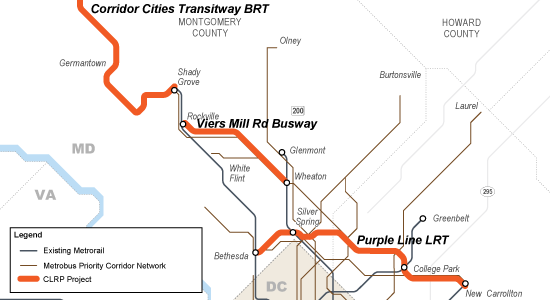What Metro 2025 Means to Maryland
Metro 2025 would bring significant benefits to Maryland, supporting its economic growth and ensuring its future vitality.
Metro’s Momentum plan calls for seven Metro 2025 initiatives – from eight-car trains to bus-only lanes, which will bring dramatic improvements to the quality of life and transportation to Maryland.
Ensures the Success of Maryland Transit Projects
Maryland has great plans for transit. The Corridor Cities Transitway, the Purple Line, and the Viers Mill Rd Busway are all included in the CLRP with a reasonable expectation for funding, and the Federal Transit Administration announced recently that the Purple Line would receive $100 million in Obama’s latest FY15 budget. Additionally, Montgomery County is developing plans for a county-wide BRT system.
These projects are worthwhile ventures, but they will always rely on the supporting regional “backbone” of Metrorail and Metrobus to deliver their intended results. At the very least, these three important projects would not connect to each other if not for Metrorail and Metrobus. And at the very worst, if these projects are built and connect to a system that is already over capacity, they may struggle to live up to their mobility goals.
- The Corridor Cities Transitway will function as a BRT extension of the Red Line: 1,500 people per peak hour will transfer to Metrorail at Shady Grove by 2030. (For context, about 3,000 riders per peak hour enter Shady Grove in the peak hour today.)
- The Viers Mill Rd Busway will connect to three Metrorail stations. The current Metrobus Q-Line, a part of the Priority Corridor Network (PCN), currently provides over 8,800 trips per day, including approximately 800 transfers a day to Metrorail.
- 10,000 Purple Line riders per day will come to and from Metrorail, where the Purple Line connects to the Red, Green, and Orange lines. Many of these passengers will further strain the over-congested lines of the rail network.

Funded Maryland transit projects, in the CLRP.
By ensuring that Metro services can keep pace with congestion and demand, Metro 2025 is critical to making Maryland’s transit projects a success, and critical to helping the region and the state reach its transportation goals.
![]()
Supports Maryland’s Growth Prospects
Maryland’s population in the Compact region is growing steadily and projected to continue growing. This growth is crucial to the economy of the state – 40% of Maryland’s state economic output came from the Washington region’s suburbs in 2012. With that growth comes significant transportation needs, and Metro 2025 is critical to meeting that growth.
- Since 2000, the population in Montgomery and Prince George’s counties has grown by 12%
- Leading this growth has been Gen Y, who increasingly take public transportation if they even have driver licenses.
- By 2040, suburban Maryland is projected to see an influx of nearly 360,000 jobs (PDF), or an increase of 42%.
When congestion goes up, job growth goes down, and if Maryland wants to see growth potential turn into actual jobs, it needs to tame congestion. Simply, Maryland needs the mobility that Metro 2025 would deliver: 8-car trains capable of moving the equivalent of 16-18 lanes of highways (in each direction) and connect Maryland to other regional job centers, superior bus service that can create much-needed east-west connections that bypass snarling congestion, and more. Read more…


Recent Comments